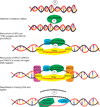Pharmacogenomics of platinum-based chemotherapy in NSCLC
- PMID: 19442035
- PMCID: PMC3417337
- DOI: 10.1517/17425250902973711
Pharmacogenomics of platinum-based chemotherapy in NSCLC
Abstract
NSCLC is the leading cause of cancer-related death in the US. Patients with NSCLC are mostly treated with platinum-based chemotherapy, often in combination with radiation therapy. However, the development of chemo-resistance is a major hurdle limiting treatment success. In this review, we summarize the current understanding of the genetic factors modulating chemoresistance to platinum chemotherapeutics and their association with clinical outcomes for NSCLC patients. We focus on candidate pathways responsible for drug influx and efflux, metabolism and detoxification, DNA damage repair, and other downstream cellular processes that modulate the effect of platinum-based therapy. We also discuss the application of pathway-based polygenic and genome-wide approaches in identifying genetic factors involved in NSCLC clinical outcomes. Overall, current studies have shown that the effects of each individual polymorphism on clinical outcomes are modest suggesting that a more comprehensive approach that incorporates polygenetic, phenotypic, epidemiologic and clinical variables will be necessary to predict prognosis for NSCLC patients receiving platinum-based chemotherapeutics.
Figures
References
-
- Parkin DM, Bray F, Ferlay J, Pisani P. Global cancer statistics, 2002. CA Cancer J Clin. 2005;55(2):74–108. - PubMed
-
- Jemal A, Siegel R, Ward E, et al. Cancer statistics, 2008. CA Cancer J Clin. 2008;58(2):71–96. - PubMed
-
- Spira A, Ettinger DS. Multidisciplinary management of lung cancer. N Engl J Med. 2004;350(4):379–392. - PubMed
-
- Rapp E, Pater JL, Willan A, et al. Chemotherapy can prolong survival in patients with advanced non-small-cell lung cancer–report of a Canadian multicenter randomized trial. J Clin Oncol. 1988;6(4):633–641. - PubMed
-
-
Chemotherapy in addition to supportive care improves survival in advanced non-small-cell lung cancer: a systematic review and meta-analysis of individual patient data from 16 randomized controlled trials. J Clin Oncol. 2008;26(28):4617–4625. •• Systematic study of supporting the advantage of including chemotherapy in the treatment of NSCLC.
-
Publication types
MeSH terms
Substances
Grants and funding
LinkOut - more resources
Full Text Sources
Other Literature Sources
Medical


